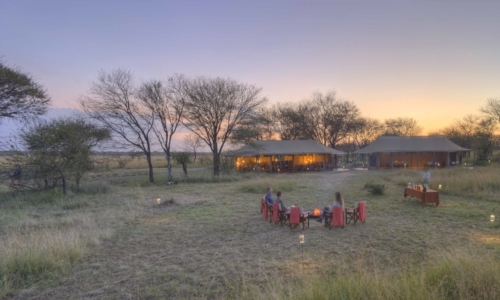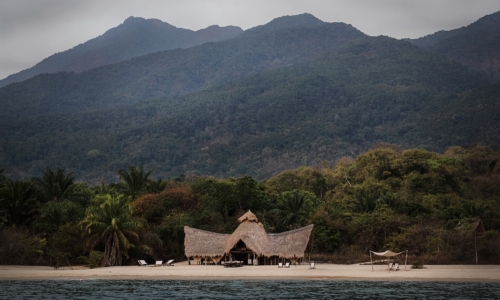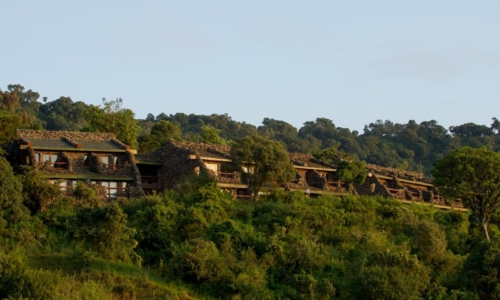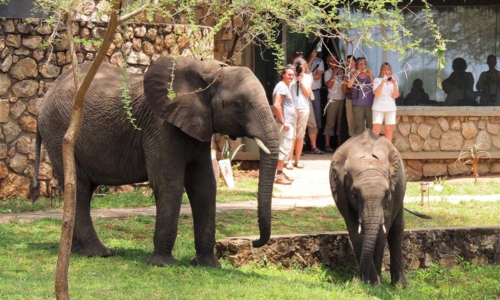Located between the Ngorongoro Conservation Area and Serengeti National Park in Tanzania, Olduvai Gorge consists of a thirty-mile steep-sided ravine that is 295 feet deep. Part of the Great Rift Valley, Olduvai is a misspelling of the local Maasai word, Oldupai for the wild sisal plant that grows in the region. More importantly, paleoanthropological evidence from 2.1 million to 15,000 years ago found in the gorge have yielded the fossil remains of more than 60 hominids and provided scientists with the most continuous known record of human evolution as well as information about the development of stone tools. It was named a UNESCO World Heritage Site in 1979.
While Wilhelm Kattwinkel and Hans Reck had noticed fossils and stone tools at the site more than a hundred years ago, World War I interrupted any further investigation until Louise Leakey and his wife, Mary came to the gorge in 1929. Convinced that the site held vital information on human origins, Louis began excavations. Their work along with the prior work of Raymond Dart and Robert Broom in South Africa convinced the scientific world that humans evolved in Africa.
Mary Leakey’s discovery of the 1.75-million-year-old fossils of Paranthropus boisei, who she called the Nutcracker Man, drastically changed the time scale of human evolution. Her son, Jonathan found the fragment of a jaw for the first fossil specimen of homo habilis, or handy man. Altogether the Leakey family, unearthed more than 2,000 stone tools. Geologist Richard L. Hay revealed that the gorge had once been a large lake whose shores where covered by volcanic ash. However, 500,000 years ago, seismic activity diverted a nearby stream which worked away at the sediment and exposed seven layers in the walls of the gorge.
Nowadays, travelers can visit Olduvai Gorge and its museum. The museum displays photographic history of the research conducted in the gorge as well as a summary of the important findings on human evolution. For an additional fee, a guide can be hired to take visitors on a walking tour of the gorge. Otherwise, safari lodges and hotels nearby can also arrange tours. Yet, most of the archeological finds can be seen in the museum.


- Bashay Rift Lodge
- Beho Beho Camp
- Chada Katavi
- Chaka Camp
- Chem Chem Lodge
- Dunia Camp
- Entamanu Ngorongoro
- Entamanu Private
- Esirai Camp
- Ewanjan Tented Camp
- Faru Faru Lodge
- Forest Chem Chem
- Fumba Beach Lodge
- Fundu Lagoon
- Gibb’s Farm
- Greystoke Mahale
- Grumeti Hills
- Grumeti Serengeti River Lodge
- Ikuka Safari Camp
- Jabali Ridge
- Jongomero
- Kaskaz Mara Camp
- Kiba Point Selous
- Kichaka
- Kichakani Serengeti Camp
- Kichuguu Camp
- Kigelia Ruaha
- Kilima
- Kiota Camp
- Kisima Ngeda Camp
- Kitela Lodge
- Klein’s Camp
- Kokoko Camp
- Kuria Hills Lodge
- Kuro Tarangire
- Kusini Kopjes Kambi
- Kusini Serengeti
- Kwihala Camp
- Lake Manyara Tree Lodge
- Lamai Serengeti
- Little Chem Chem
- Little Oliver’s Camp
- Manyara Ranch Conservancy
- Mara River Post
- Mara River Tented Camp
- Mara Tented Camp
- Maweninga Camp
- Melia Ngorongoro
- Mila Tented Camp
- Milele
- Mkombe’s House
- Mnemba Island
- Mpingo Ridge Lodge
- Mwiba Lodge
- Namiri Plains
- Naona Moru Camp
- Nasikia Mobile Camp
- Ndutu Safari Lodge
- Ndutu Tented Camp
- Ngorongoro Crater Camp
- Ngorongoro Crater Lodge
- Ngorongoro Serena Safari Lodge
- Ngorongoro Sopa Lodge
- Ngorongoro Tented Camp
- Nomad Expeditionary Walking Camp
- Nyasi Tented Camp
- Olaado Camp
- Olakira Migration Camp
- Olduvai Camp
- Olduvai Ndogo
- Oliver’s Camp
- Olkeri Camp
- Olmara Camp
- Roho ya Selous
- Ronjo Camp
- Rubondo Island Camp
- Sabora Tented Camp
- Sanctuary Serengeti Migration Camp
- Sand Rivers Selous
- Sasakwa Lodge
- Sayari Camp
- Selous Serena Camp
- Serena Mivumo River Lodge
- Serengeti Bushtops
- Serengeti House
- Serengeti Kati Kati Tented Camp
- Serengeti Migration Camp
- Serengeti Pioneer Camp
- Serengeti Safari Camp
- Serengeti Under Canvas
- Serian’s Serengeti
- Serian’s Serengeti Mobile
- Singita Explore
- Singita Kilima
- Siwandu
- Songa Migrational Camp
- Swala
- Taasa Lodge
- Tarangire Ndovu Tented Lodge
- Tarangire Safari Lodge
- Tarangire Sopa Lodge
- Tarangire Treetops
- The Highlands
- The Manor at Ngorongoro
- Ubuntu Migration Camp
- Usangu Expedition Camp
- Usawa Serengeti
- Arumeru Lodge
- Arusha Coffee Lodge
- Baraza Resort & Spa
- Breezes Beach Club & Spa
- Chole Mjini
- Dar es Salaam Serena Hotel
- Fanjove Island
- Hamerkop House
- Katambuga House
- Kilindi Zanzibar
- Lake Duluti Lodge
- Legendary Lodge
- Matemwe Beach House
- Matemwe Lodge
- Matemwe Retreat
- Ngare Sero Mountain Lodge
- Oyster Bay Hotel
- Plantation Lodge
- Rivertrees Country Inn
- The Palms
- Zanzibar Serena Hotel
- Zawadi Hotel
- Zuri Zanzibar
Coming soon!
- Bashay Rift Lodge
- Beho Beho Camp
- Chada Katavi
- Chaka Camp
- Chem Chem Lodge
- Dunia Camp
- Entamanu Ngorongoro
- Entamanu Private
- Esirai Camp
- Ewanjan Tented Camp
- Faru Faru Lodge
- Forest Chem Chem
- Fumba Beach Lodge
- Fundu Lagoon
- Gibb’s Farm
- Greystoke Mahale
- Grumeti Hills
- Grumeti Serengeti River Lodge
- Ikuka Safari Camp
- Jabali Ridge
- Jongomero
- Kaskaz Mara Camp
- Kiba Point Selous
- Kichaka
- Kichakani Serengeti Camp
- Kichuguu Camp
- Kigelia Ruaha
- Kilima
- Kiota Camp
- Kisima Ngeda Camp
- Kitela Lodge
- Klein’s Camp
- Kokoko Camp
- Kuria Hills Lodge
- Kuro Tarangire
- Kusini Kopjes Kambi
- Kusini Serengeti
- Kwihala Camp
- Lake Manyara Tree Lodge
- Lamai Serengeti
- Little Chem Chem
- Little Oliver’s Camp
- Manyara Ranch Conservancy
- Mara River Post
- Mara River Tented Camp
- Mara Tented Camp
- Maweninga Camp
- Melia Ngorongoro
- Mila Tented Camp
- Milele
- Mkombe’s House
- Mnemba Island
- Mpingo Ridge Lodge
- Mwiba Lodge
- Namiri Plains
- Naona Moru Camp
- Nasikia Mobile Camp
- Ndutu Safari Lodge
- Ndutu Tented Camp
- Ngorongoro Crater Camp
- Ngorongoro Crater Lodge
- Ngorongoro Serena Safari Lodge
- Ngorongoro Sopa Lodge
- Ngorongoro Tented Camp
- Nomad Expeditionary Walking Camp
- Nyasi Tented Camp
- Olaado Camp
- Olakira Migration Camp
- Olduvai Camp
- Olduvai Ndogo
- Oliver’s Camp
- Olkeri Camp
- Olmara Camp
- Roho ya Selous
- Ronjo Camp
- Rubondo Island Camp
- Sabora Tented Camp
- Sanctuary Serengeti Migration Camp
- Sand Rivers Selous
- Sasakwa Lodge
- Sayari Camp
- Selous Serena Camp
- Serena Mivumo River Lodge
- Serengeti Bushtops
- Serengeti House
- Serengeti Kati Kati Tented Camp
- Serengeti Migration Camp
- Serengeti Pioneer Camp
- Serengeti Safari Camp
- Serengeti Under Canvas
- Serian’s Serengeti
- Serian’s Serengeti Mobile
- Singita Explore
- Singita Kilima
- Siwandu
- Songa Migrational Camp
- Swala
- Taasa Lodge
- Tarangire Ndovu Tented Lodge
- Tarangire Safari Lodge
- Tarangire Sopa Lodge
- Tarangire Treetops
- The Highlands
- The Manor at Ngorongoro
- Ubuntu Migration Camp
- Usangu Expedition Camp
- Usawa Serengeti
- Arumeru Lodge
- Arusha Coffee Lodge
- Baraza Resort & Spa
- Breezes Beach Club & Spa
- Chole Mjini
- Dar es Salaam Serena Hotel
- Fanjove Island
- Hamerkop House
- Katambuga House
- Kilindi Zanzibar
- Lake Duluti Lodge
- Legendary Lodge
- Matemwe Beach House
- Matemwe Lodge
- Matemwe Retreat
- Ngare Sero Mountain Lodge
- Oyster Bay Hotel
- Plantation Lodge
- Rivertrees Country Inn
- The Palms
- Zanzibar Serena Hotel
- Zawadi Hotel
- Zuri Zanzibar
Coming soon!

Located between the Ngorongoro Conservation Area and Serengeti National Park in Tanzania, Olduvai Gorge consists of a thirty-mile steep-sided ravine that is 295 feet deep. Part of the Great Rift Valley, Olduvai is a misspelling of the local Maasai word, Oldupai for the wild sisal plant that grows in the region. More importantly, paleoanthropological evidence from 2.1 million to 15,000 years ago found in the gorge have yielded the fossil remains of more than 60 hominids and provided scientists with the most continuous known record of human evolution as well as information about the development of stone tools. It was named a UNESCO World Heritage Site in 1979.
While Wilhelm Kattwinkel and Hans Reck had noticed fossils and stone tools at the site more than a hundred years ago, World War I interrupted any further investigation until Louise Leakey and his wife, Mary came to the gorge in 1929. Convinced that the site held vital information on human origins, Louis began excavations. Their work along with the prior work of Raymond Dart and Robert Broom in South Africa convinced the scientific world that humans evolved in Africa.
Mary Leakey’s discovery of the 1.75-million-year-old fossils of Paranthropus boisei, who she called the Nutcracker Man, drastically changed the time scale of human evolution. Her son, Jonathan found the fragment of a jaw for the first fossil specimen of homo habilis, or handy man. Altogether the Leakey family, unearthed more than 2,000 stone tools. Geologist Richard L. Hay revealed that the gorge had once been a large lake whose shores where covered by volcanic ash. However, 500,000 years ago, seismic activity diverted a nearby stream which worked away at the sediment and exposed seven layers in the walls of the gorge.
Nowadays, travelers can visit Olduvai Gorge and its museum. The museum displays photographic history of the research conducted in the gorge as well as a summary of the important findings on human evolution. For an additional fee, a guide can be hired to take visitors on a walking tour of the gorge. Otherwise, safari lodges and hotels nearby can also arrange tours. Yet, most of the archeological finds can be seen in the museum.

- Bashay Rift Lodge
- Beho Beho Camp
- Chada Katavi
- Chaka Camp
- Chem Chem Lodge
- Dunia Camp
- Entamanu Ngorongoro
- Entamanu Private
- Esirai Camp
- Ewanjan Tented Camp
- Faru Faru Lodge
- Forest Chem Chem
- Fumba Beach Lodge
- Fundu Lagoon
- Gibb’s Farm
- Greystoke Mahale
- Grumeti Hills
- Grumeti Serengeti River Lodge
- Ikuka Safari Camp
- Jabali Ridge
- Jongomero
- Kaskaz Mara Camp
- Kiba Point Selous
- Kichaka
- Kichakani Serengeti Camp
- Kichuguu Camp
- Kigelia Ruaha
- Kilima
- Kiota Camp
- Kisima Ngeda Camp
- Kitela Lodge
- Klein’s Camp
- Kokoko Camp
- Kuria Hills Lodge
- Kuro Tarangire
- Kusini Kopjes Kambi
- Kusini Serengeti
- Kwihala Camp
- Lake Manyara Tree Lodge
- Lamai Serengeti
- Little Chem Chem
- Little Oliver’s Camp
- Manyara Ranch Conservancy
- Mara River Post
- Mara River Tented Camp
- Mara Tented Camp
- Maweninga Camp
- Melia Ngorongoro
- Mila Tented Camp
- Milele
- Mkombe’s House
- Mnemba Island
- Mpingo Ridge Lodge
- Mwiba Lodge
- Namiri Plains
- Naona Moru Camp
- Nasikia Mobile Camp
- Ndutu Safari Lodge
- Ndutu Tented Camp
- Ngorongoro Crater Camp
- Ngorongoro Crater Lodge
- Ngorongoro Serena Safari Lodge
- Ngorongoro Sopa Lodge
- Ngorongoro Tented Camp
- Nomad Expeditionary Walking Camp
- Nyasi Tented Camp
- Olaado Camp
- Olakira Migration Camp
- Olduvai Camp
- Olduvai Ndogo
- Oliver’s Camp
- Olkeri Camp
- Olmara Camp
- Roho ya Selous
- Ronjo Camp
- Rubondo Island Camp
- Sabora Tented Camp
- Sanctuary Serengeti Migration Camp
- Sand Rivers Selous
- Sasakwa Lodge
- Sayari Camp
- Selous Serena Camp
- Serena Mivumo River Lodge
- Serengeti Bushtops
- Serengeti House
- Serengeti Kati Kati Tented Camp
- Serengeti Migration Camp
- Serengeti Pioneer Camp
- Serengeti Safari Camp
- Serengeti Under Canvas
- Serian’s Serengeti
- Serian’s Serengeti Mobile
- Singita Explore
- Singita Kilima
- Siwandu
- Songa Migrational Camp
- Swala
- Taasa Lodge
- Tarangire Ndovu Tented Lodge
- Tarangire Safari Lodge
- Tarangire Sopa Lodge
- Tarangire Treetops
- The Highlands
- The Manor at Ngorongoro
- Ubuntu Migration Camp
- Usangu Expedition Camp
- Usawa Serengeti
- Arumeru Lodge
- Arusha Coffee Lodge
- Baraza Resort & Spa
- Breezes Beach Club & Spa
- Chole Mjini
- Dar es Salaam Serena Hotel
- Fanjove Island
- Hamerkop House
- Katambuga House
- Kilindi Zanzibar
- Lake Duluti Lodge
- Legendary Lodge
- Matemwe Beach House
- Matemwe Lodge
- Matemwe Retreat
- Ngare Sero Mountain Lodge
- Oyster Bay Hotel
- Plantation Lodge
- Rivertrees Country Inn
- The Palms
- Zanzibar Serena Hotel
- Zawadi Hotel
- Zuri Zanzibar
Coming soon!
- Bashay Rift Lodge
- Beho Beho Camp
- Chada Katavi
- Chaka Camp
- Chem Chem Lodge
- Dunia Camp
- Entamanu Ngorongoro
- Entamanu Private
- Esirai Camp
- Ewanjan Tented Camp
- Faru Faru Lodge
- Forest Chem Chem
- Fumba Beach Lodge
- Fundu Lagoon
- Gibb’s Farm
- Greystoke Mahale
- Grumeti Hills
- Grumeti Serengeti River Lodge
- Ikuka Safari Camp
- Jabali Ridge
- Jongomero
- Kaskaz Mara Camp
- Kiba Point Selous
- Kichaka
- Kichakani Serengeti Camp
- Kichuguu Camp
- Kigelia Ruaha
- Kilima
- Kiota Camp
- Kisima Ngeda Camp
- Kitela Lodge
- Klein’s Camp
- Kokoko Camp
- Kuria Hills Lodge
- Kuro Tarangire
- Kusini Kopjes Kambi
- Kusini Serengeti
- Kwihala Camp
- Lake Manyara Tree Lodge
- Lamai Serengeti
- Little Chem Chem
- Little Oliver’s Camp
- Manyara Ranch Conservancy
- Mara River Post
- Mara River Tented Camp
- Mara Tented Camp
- Maweninga Camp
- Melia Ngorongoro
- Mila Tented Camp
- Milele
- Mkombe’s House
- Mnemba Island
- Mpingo Ridge Lodge
- Mwiba Lodge
- Namiri Plains
- Naona Moru Camp
- Nasikia Mobile Camp
- Ndutu Safari Lodge
- Ndutu Tented Camp
- Ngorongoro Crater Camp
- Ngorongoro Crater Lodge
- Ngorongoro Serena Safari Lodge
- Ngorongoro Sopa Lodge
- Ngorongoro Tented Camp
- Nomad Expeditionary Walking Camp
- Nyasi Tented Camp
- Olaado Camp
- Olakira Migration Camp
- Olduvai Camp
- Olduvai Ndogo
- Oliver’s Camp
- Olkeri Camp
- Olmara Camp
- Roho ya Selous
- Ronjo Camp
- Rubondo Island Camp
- Sabora Tented Camp
- Sanctuary Serengeti Migration Camp
- Sand Rivers Selous
- Sasakwa Lodge
- Sayari Camp
- Selous Serena Camp
- Serena Mivumo River Lodge
- Serengeti Bushtops
- Serengeti House
- Serengeti Kati Kati Tented Camp
- Serengeti Migration Camp
- Serengeti Pioneer Camp
- Serengeti Safari Camp
- Serengeti Under Canvas
- Serian’s Serengeti
- Serian’s Serengeti Mobile
- Singita Explore
- Singita Kilima
- Siwandu
- Songa Migrational Camp
- Swala
- Taasa Lodge
- Tarangire Ndovu Tented Lodge
- Tarangire Safari Lodge
- Tarangire Sopa Lodge
- Tarangire Treetops
- The Highlands
- The Manor at Ngorongoro
- Ubuntu Migration Camp
- Usangu Expedition Camp
- Usawa Serengeti
- Arumeru Lodge
- Arusha Coffee Lodge
- Baraza Resort & Spa
- Breezes Beach Club & Spa
- Chole Mjini
- Dar es Salaam Serena Hotel
- Fanjove Island
- Hamerkop House
- Katambuga House
- Kilindi Zanzibar
- Lake Duluti Lodge
- Legendary Lodge
- Matemwe Beach House
- Matemwe Lodge
- Matemwe Retreat
- Ngare Sero Mountain Lodge
- Oyster Bay Hotel
- Plantation Lodge
- Rivertrees Country Inn
- The Palms
- Zanzibar Serena Hotel
- Zawadi Hotel
- Zuri Zanzibar
Coming soon!


































